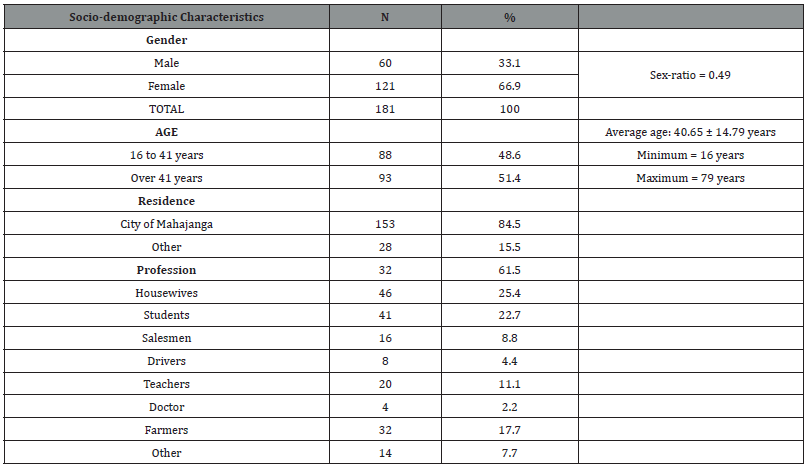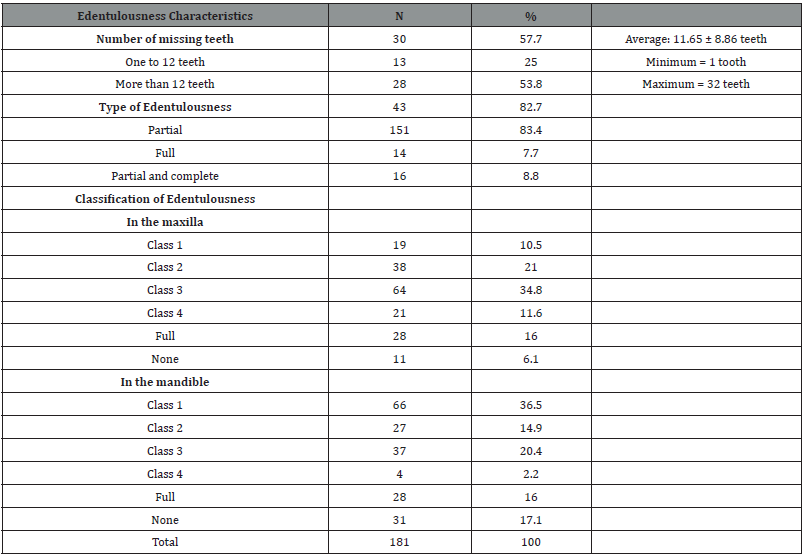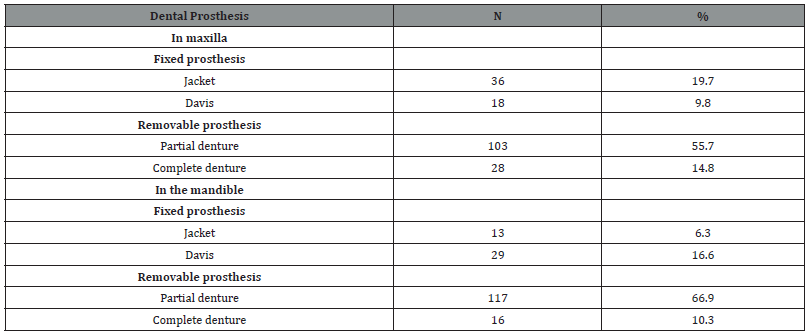 Research Article
Research Article
Epidemio-Clinical Profile of Edentulousness of Patients Who Came for Prosthetic Restoration to the Dental Care and Treatment Centre in Mahajanga from 2015 to 2019
Naomy Namboarintsoa Ratsimandresy1*, Delina Nathalie Rasoamalala2 and Liantsoa Fanja Emmanuel Ralaiarimanana1
1Department of Prosthodontics at Tropical Odonto-Stomatological Institute of Madagascar (IOSTM), University of Madagascar, Madagascar
2Dental care and treatment centre (CSTD) IOSTM Mahajanga Madagascar, Madagascar
Naomy Namboarintsoa Ratsimandresy, Department of Prosthodontics, at Tropical Odonto-Stomatological Institute of Madagascar (IOSTM). University of Mahajanga, Madagascar.
Received Date:January 23, 2023; Published Date: February 09, 2023
Abstract
Objective: The aim of this study was to describe the epidemio-clinical profile of edentulous of patients who came for prosthetic restoration to the dental care and treatment centre (CSTD) in the Tropical Odonto-Stomatological Institute of Madagascar (IOSTM) in Mahajanga Madagascar from 2015 to 2019.
Methodology: A retrospective descriptive study was conducted at CSTD of IOSTM in Mahajanga Madagascar from 2015 to 2019, Recruitment was exhaustive from the medical records of patients who came for consultation for prosthetic restoration. All inadequately completed medical records were excluded. A total of 181 patients were included. Socio-demographic characteristics, edentulousness characteristics and edentulousness therapy were the study variables.
Results: Of the 181 edentulous patients, the majority were women (66.9%) with a sex-ratio equal to 0.49. The average number of missing teeth was equal to 11.65 ± 8.86 teeth and 53.6% of the patients had one to 12 missing teeth. Class 3 edentulousness was the most frequently diagnosed in the maxilla and class 1 in the mandible. In the maxilla, 55.7% of the prostheses worn were Partial removable denture, 29.5% were Fixed Prosthesis (FP) and 14.8% were complete removable denture and in the mandible, 66.9% of the prostheses worn were Partial removable denture, 22.9% FP and 10.3% complete removable denture.
Suggestions:Patients should be made aware of edentulousness and therapeutic means so that they receive various information and knowledge in order to motivate them to restore missing teeth.
Keywords: Edentulousness, Orofile, Epidemio clinical
Introduction
Edentulousness usually results from oral diseases, mainly advanced dental caries and severe periodontal disease, but it can also be caused by trauma or other causes [1]. The global average prevalence of edentulousness is estimated to be around 7% in people aged 20 years or older. For people aged 60 years or older, the es- timated global prevalence is much higher, at 23% [1]. In Africa, in 2015 a study in an urban population in Senegal (Dakar) found that 40.9% of the population are edentulous [2]. In Madagascar tooth extraction leading to edentulousness is still a more common practice. But among the edentulous, the proportion of denture wearers is still low according to available data [3]. To lose teeth can be psychologically traumatic, socially damaging and functionally limiting [1]. Prosthetic restoration is one solution to remedy the consequences of tooth loss. The therapy that uses prosthetic restoration will depend on the clinical characteristics of the edentulousness.
Therefore, these clinical characteristics of edentulousness must be controlled by the practitioners to ensure effective management of the patients. The present study aims to describe the epidemio- clinical profile of edentulous patients who came for consultation for prosthetic restoration to the CSTD from 2015 to 2019.
Methodology
This study was carried out at the CSTD of IOSTM in the town of Mahajanga, Madagascar. The CSTD is a place of internship and practical training for students in M1 and M2 of the odontostomatology mention and for students in L2 and L3 of the dental assistant mention of the IOSTM, which is the only training centre for odontostomatology in Madagascar. This was a retrospective descriptive study based on the consultation of the files of edentulous patients who came to the CSTD for dental prosthesis during the period studied. Universal variables (gender, age, residence and occupation), number of missing teeth, clinical characteristics of edentulous patients and types of prosthetic restoration were studied. For data analysis, the Statistical package for the social sciences (SPSS) version 20.0 for WINDOWS was used. The Pearson chi-square test was used to see the relationship between the independent and dependent variables.
Results
Table 1:Distribution of patients by socio-demographic characteristics.

N: Number %: Percent
- Acording to the gender: 66.9% of the patients were female,
with a sex ratio equal to 0.49.
-On Age: the average age of the patients was 40.65 ± 14.79
years. Age ranged from 16 to 79 years and the age group of 41 years
and over was the majority (51.4%).
- Regarding place of residence: patients from the city of Mahajanga
predominated at 84.5%.
-As for profession: housewives were in the majority at 25.4%.
Table 2:Distribution of patients according to edentulousness characteristics.

The average number of missing teeth was 11.65 ± 8.86 teeth. The number of missing teeth of the patients ranged from 1 to 32 teeth and the range of 1 to 12 missing teeth was the majority (53.6%).
According to the type of edentulousness, it was found that 83.4% of the patients were partially edentulous.
The distribution of the patients according to the edentulousness classification (according to kennedy) on the dental arches showed that in the maxilla, class III edentulousness predominated at 34.8% and 21.0% were class II. In the mandible, class I edentulousness presented 36.5% and 20.4% were class III.
Table 3:Distribution of patients by type of dental prosthesis.

Concerning the types of dental prosthesis in the maxilla, 19.7% of the dental prostheses were fixed prostheses (crown jackets). And 55.7% were partial removable resin dentures. As for the types of dental prosthesis in the mandible, 16.6% were fixed prostheses (Davis). And 66.9% were partial removable resin dentures.
Table 4:Distribution of patients by number of missing teeth and age.

Seventy-five percent (75.0%) of patients aged 16-41 years and 33.4% of patients over 41 years had 1-12 missing teeth. While 25.0% of patients aged 16-41 years and 66.7% of patients over 41 years had more than 12 missing teeth. It was found that the number of missing teeth increases with age. This result is highly significant (***p=0.000).
Table 5:Distribution of patients by number of missing teeth and periodontal disease.

Fifty-nine percent (59.0%) of the patients who had gingivitis, 45.2% of the patients who had gingival recession, 37.5% of the patients who had periodontal pocket and 16.7% of the patients who had tooth mobility had 1 to 12 missing teeth.
-While 41.0% of the patients with gingivitis, 54.8% of the patients with gingival recession, 62.5% of the patients with periodontal pocket and 83.3% of the patients with tooth mobility had more than 12 missing teeth. It was found that the number of missing teeth increased with the degree of periodontal disease. This result is highly significant (***p=0.000).,/
Discussion
Socio-demographic characteristics of patients
A predominance of the female gender was found in this study. This corroborates the study of Gueye in Senegal who also found a female predominance of edentulous people with 52.4% [2]. Patient age ranged from 16 to 79 years, with just over half of the patients being in the 41+ age group. And in relation to occupation, housewives were the most represented followed by students. These results differ from those of a study in Senegal in 2014 which found that patients belonging to the retired group were more represented [4]. The majority of patients were domiciled in the City of Mahajanga. This result seems logical since this study involved patients at the IOSTM CSTD which is located in the said City.
Clinical characteristics of edentulousness
Number of missing teeth
The number of missing teeth ranged from 1 to 32 teeth with a mean number of missing teeth of 11.65 ± 8.86 teeth. This average is higher than that found by Ratsimandresy and al in 2016 in Fianarantsoa Madagascar with 8.57 ± 4.34 missing teeth per person [3]. And also higher than that found by Sokolo with an average of 3.6 missing teeth ± 3.12 [5]. The range of 1 to 12 missing teeth was the majority. The high frequency of edentulousness is still an uncontrolled phenomenon, especially in developing countries [6].
Number of missing teeth and age
Three quarters of the patients aged from 16 to 41 years had 1 to 12 missing teeth. The majority of patients over 41 years of age had more than 12 missing teeth. It was found that the number of missing teeth increased with age. This result corroborates Hue’s finding and Dupuis also confirmed that patients who are older become more and more edentulous [7, 8].
Number of missing teeth and periodontal disease
It was found that the number of missing teeth increased with the degree of periodontal disease. Indeed, patients who have had dental mobility have had more missing teeth. This seems logical as these mobile teeth, at an advanced stage will be extracted, which constitutes edentulousness.
Type of edentulousness
The majority of patients were partially edentulous. A different result was found by Gueye in his study. In his study, 62.7% of his sample were completely edentulous, while anterior or posterior edentulousness constituted 37.3% [4].
Classification of edentulousness
In the maxilla, class 3 and class 2 edentulousness predominated. In the mandible, class 1 and class 3 edentulousness were predominant. Coulibaly and al in their study in Bamako in 2020 found a predominance of edentulousness in the molar regions (82.81% of cases) [9].
Type of dental prosthesis
In this study, the partial removable denture was the most diagnosed type of prosthesis with 55.7% in the maxilla and 66.9% in the mandible. Then 43.7% of the patients studied wore only partial removable dentures. And all the partial removable dentures were made of resin. Azzaz, et al. in 2013 in Casablanca found that 48% of edentulous subjects in maxilla were prosthesis wearers and less than 18% in mandible [10]. Several prosthetic therapies are available to treat these patients: removable prosthesis, fixed prosthesis and implant supported prosthesis [11]. In Kinshasa, edentulous patients are largely rehabilitated with acrylic resin partial removable dentures [12]. The same is true in other African countries, such as Senegal and Bukina Faso, where almost half of the partially edentulous teeth are compensated by temporary resin dentures [4].
Conclusion
From the analysis of the 181 patient records collected in this study, the number of missing teeth was high, partial edentulousness, class 3 and class 1 edentulousness predominated. And these gaps were mostly restored with resin partial removable dentures. The challenge remains to raise the awareness of patients in order to motivate them to restore their missing teeth.
Acknowledgement
None.
Conflict of Interest
No conflict of interest.
References
- World organization health (2022) Global oral health status report: towards universal health coverage for oral health by 2030. Executive summary p: 10
- Gueye M, Mbodj EB, Dieng L, Seck AK, Toure A, Thioune N (2015) Evaluation of the prevalence of edentulousness in an urban population in Senegal. Rev Iv Odonto-Stomatol 17(2): 15-20.
- Ratsimandresy NN, Andriamamimalala MH, Rakotondratsara MA, Ralaiarimanana LFE (2020) Knowledge, attitude and practice of the population of the city of Fianarantsoa towards the replacement of missing teeth. Rosmel 18: 1-10.
- Gueye M, Mbodj EB, Dieng L, Thioune N, Toure A, Seck MT (2014) Characteristics socio-economic des patients réhabilité Rev Iv Odonto-Stomatol 6(n°2): 21-26.
- Sokolo R, Konde J, Bakambana G, Kubiluka J, Songo F, et al. (2022) Sociodemographic study of the Treatment of Edentulous Dentures by Dental Implants in Kinshasa. Health Sci Dis 23(4): 16-21.
- Fall M, Sawadogo A, Ouédraogo Y, Diarra AA, Ouédraogo S (2019) Dentures wearing: investigation in dental offices in the city of Ouagadougou. Rev Col Odonto-Stomatol Afr Chir Maxillo Fac 26(N°1): 29-34.
- Hue O, Berteretche MV (2004) Complete Denture: Clinical reality therapeutic solutions. Paris: Quintessence International p: 289.
- Dupuis V (2013) The oral health of the elderly: what issues for oral health of the elderly? 13th Public Dental Health Day France.
- Coulibaly B, Kéita DB, Touré K, Kamissoko K , Diallo B, et al. (2020) Assessment of dental prosthesis needs of patients in the service of hepato-gastroenterology CHU Gabriel Toure of Bamako MASAP X (02): 40-43.
- Azzaz A, Meriem A (2013) Needs and demands of prosthetic treatments in the population followed at the prosthetic services of the CCTD of Casablanca. 21st International Dental Congress CRON-OM. Morocco.
- Kouame KM, Kouadio KR, Kouadio AA, Amani SR, Koffi NJ, et al. (2020) Place of implant-supported restorations in prosthetic therapy in Côte d'Ivoire: Survey of dental surgeons in the Abidjan district. Rev Iv Odonto Stomatol 22(1): 31-36.
- Sekele IB, Naert I, Lutula PS, Ntumba MK, Bolenge I, et al. (2016) Influence of acrylic resin partial denture on oral health and quality of life. Odonto stomatol Trop 39(153): 36-46.
-
Naomy Namboarintsoa Ratsimandresy*, Delina Nathalie Rasoamalala and Liantsoa Fanja Emmanuel Ralaiarimanana. Epidemio-Clinical Profile of Edentulousness of Patients Who Came for Prosthetic Restoration to the Dental Care and Treatment Centre in Mahajanga from 2015 to 2019. On J Dent & Oral Health. 6(5): 2023. OJDOH.MS.ID.000646.
-
Dental care, Missing teeth, Removable denture, Dental prosthesis, Fixed prostheses, Periodontal disease, Teeth, Anterior or posterior edentulousness, Maxilla, Edentulous teeth.
-

This work is licensed under a Creative Commons Attribution-NonCommercial 4.0 International License.






